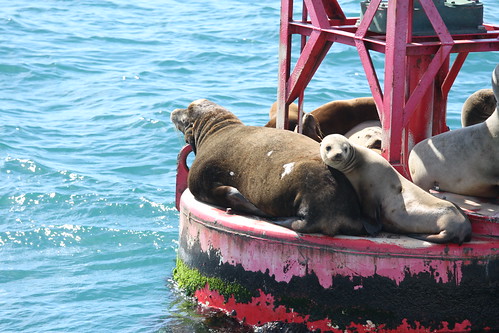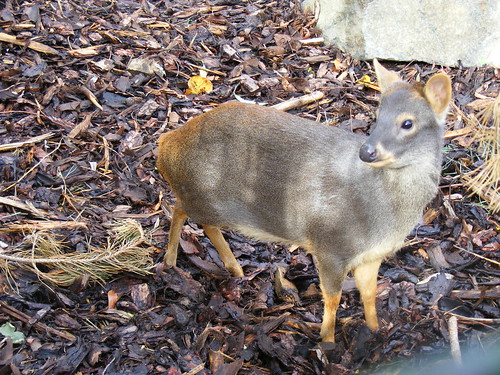10 Animals Born This Year Are More Rare Than a Royal Baby

Even if you weren’t really paying attention to the news this past week, it was hard to avoid coverage of the birth of the baby now known as Prince George Alexander Louis on July 22. The newborn, otherwise known as the “royal baby,” was hardly the only notable birth this year. Quite a few new babies who are endangered species — rarer even than a royal baby — have been born in 2013.
1. A Malayan Tapir

Earlier this month and for the first time in 20 years, the Minnesota Zoo welcomed the birth of a rare Malayan tapir, a tropical animal that is one of the most endangered in southeast Asia. The new calf was born after a 419-day gestation period (a pregnancy that was long even by tapir standards). For the first six months, the tapir calf will look like a “furry watermelon with legs,” albeit one weighing about 20 pounds — but it will weigh about 450 pounds in a year. With a face more resembling an anteater’s or pig’s, the tapir’s closest relatives are horses and rhinoceroses.
2. Twin Giant Panda Cubs
 Photo via Jay Alvin Dimla/Flickr
Photo via Jay Alvin Dimla/Flickr
A giant panda, Lun Lun, gave birth to twin panda cubs on July 15. The cubs (both boys) are the first pandas to be born this year in the U.S. and the first twins to be born since 1987; they join three older brothers born to Lun Lun and Yang Yang at the Atlanta Zoo. As pandas can only care for one cub at a time, keepers are placing one in an incubator while his brother remains with Lun Lun. Now with a brood of five, she is certainly an experienced mother.
3. A Clouded Leopard

Reshmi, a clouded leopard, gave birth to a baby on June 8 at the Sipahijala Wildlife Sanctuary in Tripura, one of 42 breeding centers in India. Fewer than 10,000 clouded leopards remain in their habitat in the Himalayan Mountains between India and China; six clouded leopards, who are listed as a vulnerable species by the IUCN and endangered in the U.S.. live at the Sipahijala Wildlife Sanctuary. They are thought to be the evolutionary link between small cats and big cats and to have a primitive form of saber-toothedness like that of saber-toothed cats 10,000 years ago; due to their rarity, scientists have not been able to study them much.
4. A Spectacle Monkey

The Sipahijala Wildlife Sanctuary welcomed the birth of another rare animal, the spectacle monkey or Phayre’s leaf monkey, on May 28. Living exclusively in trees, the adults have distinct white rings around their eyes. The spectacle monkey is now listed as endangered as a result of habitat degradation, hunting and human settlement; their numbers have declined more than 80 percent in the last 20 years in Bangladesh alone.
5. Three Chacoan Peccaries
Video via SDZoo/YouTube
Three endangered Chacoan peccary babies were born on June 19 at the San Diego zoo. Peccaries are medium-sized piglike mammals that are thought to be the closest living relative to Platygonus, an extinct genus that lived thousands of years ago. Only about 5,000 peccaries remain in the wild in Paraguay, with several thousand more estimated to live in Argentina and Bolivia. Habitat destruction and disease have taken a huge toll on the numbers of peccaries in the wild.
6. A Steller Sea Lion
 Photo of sea lions including a pup in southern California via Ken Lund/Flickr
Photo of sea lions including a pup in southern California via Ken Lund/Flickr
A Steller sea lion pup was born on June 20 to 13-year-old Eden and 20-year-old Woodie at the Alaska SeaLife Center. The new female pup is the first to be born at the Center and the first born in North America since the 1980s. Researchers estimate that about 15 percent of Steller sea pups born in the wild do not survive more than a week; another of the Center’s sea lions, Tasu, had delivered a stillborn pup just weeks before. The new pup’s birth is definitely something to celebrate: the overall population of sea lions has declined by 80 percent over the past 30 years. About 40,000 are estimated to live throughout the Northern Pacific Rim from Japan to central California.
7. A Southern Pudu
 Photo via Marie Hale/Flickr
Photo via Marie Hale/Flickr
Native to Chile and Argentina, the Southern Pudu is the world’s smallest deer. One was born on May 3 at the Queens Zoo far from her native rainforest habitat, which has been vastly altered due to logging, agriculture and cattle ranching. Southern Pudus have been over-hunted and captured illegally as pets; they also are very susceptible to diseases from parasites. The new Pudu in Queens was born to parents Josephine and Hamilton and will weigh about 20 pounds when full grown.
8. An Indian Rhinoceros
Video via Cincinnati Zoo Tube/YouTube
Born on June 5 at the Montgomery Zoo in Alabama, Ethan already weighs a couple hundred pounds. He is reportedly thriving and is the first rhino born in the U.S. to be conceived via artificial insemination; Jeta, Ethan’s mother, was injected with frozen sperm from a Cincinnati Zoo male rhino collected in 2004. She had previously given birth to two rhinos naturally; her caretakers attempted artificial insemination after there was “behavioral incompatibility” between her and a male rhino. Ethan is one of about 60 Indian rhinos in captivity in the U.S.; only about 2,500 survive in the wild.
9. Amur Tiger Twins

Two amur tigers were born on July 6 at the Sedgwick County Zoo in Kansas. The two new cubs were naturally conceived; earlier this year, their mother, Talal, had given birth to one conceived via artificial insemination but the cub died after 36 hours. The largest of the species of tigers, only about 40 amur tigers remained in the wild by the 1940s. Thanks to strict anti-poaching policies, about 450 are estimated to live in their native habitat in the Russian Far East and northern China.
10. A Przewalski’s Horse Foal
 Photo via Buckeye Beth/Flickr
Photo via Buckeye Beth/Flickr
Also known as the Mongolian wild horse or the Asiatic wild horse and the last remaining breed of wild horse, a Przelwalski’s horse foal was born in June at the Denver Zoo. The Przewalski’s horse lived on the German and Russian steppes to Kazakhstan, Mongolia and northern China until the late 18th century. Afterwards, its numbers declined precipitously; a wild one was last seen in 1969; starting in the 1990s, they have been reintroduced to Mongolia.
Read more: big cat, deer, deforestation, endangered species, habitat destruction, leopard, monkey, peccary, rain forest, rhino, rhinoceros, royal baby, tiger
Photos via Thinkstock (unless otherwise noted)
Read more: http://www.care2.com/causes/10-animals-born-this-year-who-are-more-rare-than-a-royal-baby.html#ixzz2aWhsVzfc